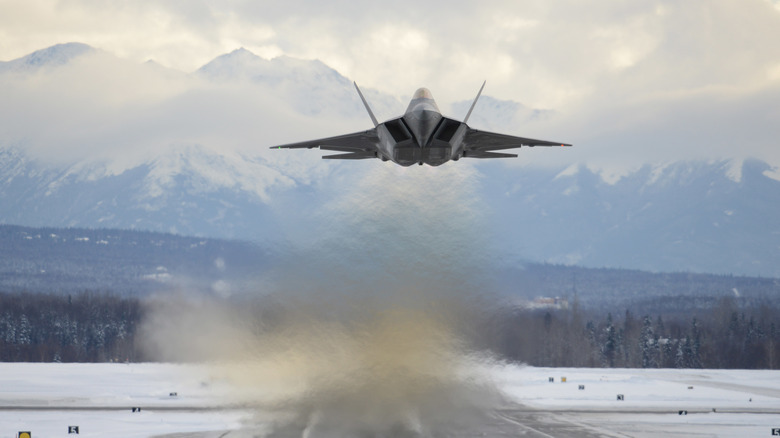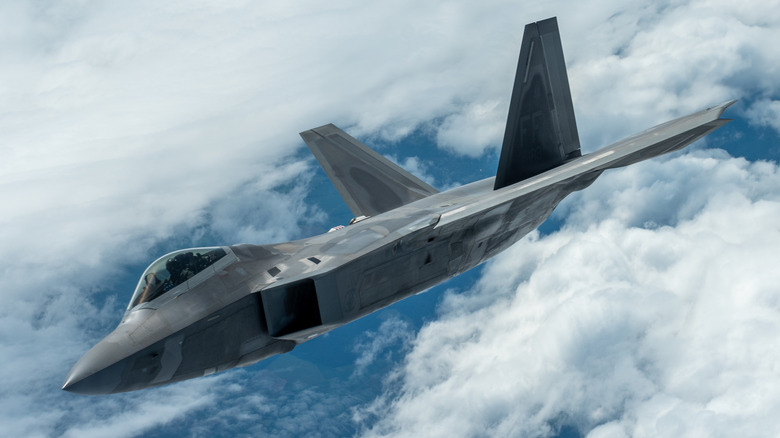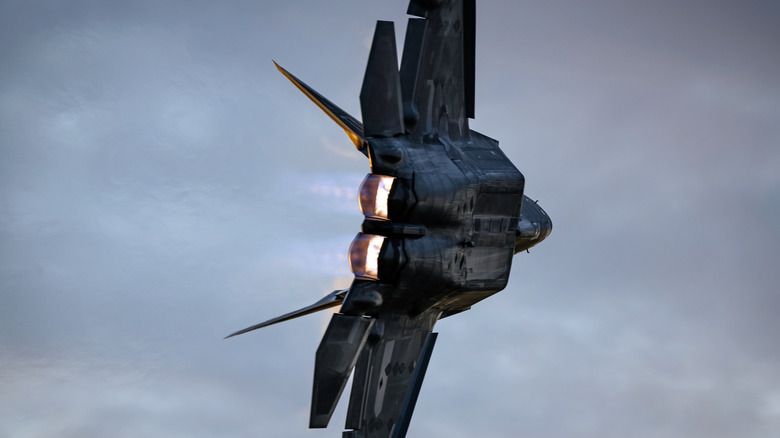Who Designed The F-22 Raptor, And Where Were The Fighter Jets Built?
The F-22 made headlines in July 2025 when the Air Force released its latest budget request, which included $90 million in improvements for the stealth fighter, including infrared defensive systems, enhanced radar, electronic warfare, and stealth features. The move comes as the Pentagon initiates production of the sixth-generation fighter jet, Boeing's F-47, proving that the fifth-generation fighter remains a major figure in America's defense systems.
Manufactured through a partnership with Boeing and Pratt & Whitney, Lockheed Martin's one-seater delivers high-end stealth and long-range supercruise capabilities with advanced arsenals. Capable of Mach 2 speeds, a range of 1,850 miles, and sporting a state-of-the-art sensor suite, the U.S.'s 183 F-22s remain one of the world's most advanced fighter jet fleets, infamous for its first-kill capabilities.
Although final assembly and testing of the stealth fighter took place in Lockheed Martin's facilities in Marietta, Georgia, building the fifth-generation jet was a truly national effort, involving many suppliers across the United States. Many of these partners have continued to work with Lockheed Martin to fulfill the DoD's strategic upgrades despite the F-22 being discontinued in 2011. For instance, in 2025, Pratt & Whitney announced that its Connecticut facilities received a $1.5 billion contract to upgrade the jet's engines. Considering the Pentagon's further investments in the F-22 program despite the impending arrival of a new generation of aircraft, now is as good a time as any to review the jet's production history.
Birth of a stealth fighter
Although the Raptor completed its first operational test in 2004, its story goes back to the height of the Cold War, when the U.S. sought to counter the Soviets' superior air numbers in the event of an Eastern European conflict. In response to this threat, the U.S. Defense Resources Board began searching for an air superiority fighter to join its fleet alongside the F-15 in 1981. The competition to build the world's most advanced tactical fighter spanned a decade, until a consortium of Lockheed Martin, Boeing, and General Dynamics won the contract.
Led by aeronautical engineer Vinny Devino, the team, which included Pratt & Whitney as the engine's subcontractor, spent the following six years refining its designs. It put its YF-22 prototype through 44,000 wind tunnel hours and 13,000 material sample tests before finally rolling out the first F-22 Raptor in 1997. It would take another eight years before the Raptor was deemed operational, officially making its Air Force debut in 2005.
The United States would add 187 F-22s to its fleet during the early 2000s. Despite its status as one of the world's premier fighter jets, the F-22 didn't make its combat debut until 2014, even though production ended in 2011. This sparked concerns over the program's long-term viability, but that has been disproven by the Raptor's continued software and hardware updates, including those mentioned in the Air Force's 2026 budget proposal. These updates, which will be applied to the Pentagon's fleet of 143 combat-coded F-22s, will improve everything from the fighter's pilot interface and cybersecurity infrastructure to its infrared defense systems and low observability capabilities.
Assembling an F-22
Like many military-grade jets, building an F-22 Raptor was a massive undertaking. While Lockheed Martin put the finishing touches on the jets in its Marietta, Georgia, facilities, assembling a Raptor also involved 1,000 suppliers from all but eight U.S. states. In addition to its final assembly location, the Maryland-based Lockheed Martin built the F-22 in its facilities in Palmdale, California, Meridian, Mississippi, and Fort Worth, Texas.
The jet is propelled by two Pratt & Whitney F119-PW-100 turbofan engines capable of producing a collective 70,000 pounds of thrust — more than any other on the market. From its factories in Hartford and Middletown, Connecticut, Pratt & Whitney equipped the F119 engines with afterburners and two-dimensional thrust vectoring nozzles, enabling them to deliver impressive speed. For instance, the fighter jet can hit supersonic speeds before engaging these afterburners, helping the F-22 Raptor reach top speeds exceeding Mach 2 — roughly twice the speed of sound at 1,500 mph.
Boeing, for its part, built the Raptor's unique wings and aft fuselage at its Development Center in Seattle, Washington. Constructed of mostly titanium alloys and graphite composites, the wings give the Raptor a 44-and-a-half-foot wingspan. Boeing was also responsible for integrating and testing the aircraft's advanced avionics and several of its auxiliary systems, including pilot and maintenance training.


